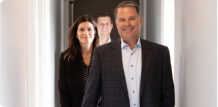The end of summer marks an amazing period of transition for the modern American family. Until recently, I never understood why so many waited until the very same two or three weeks in late July and early August to squeeze in a last minute beach vacation. The trend is so pronounced that in our industry, trading volumes markedly decline in August. Like the slowly falling waistlines of modern denim, I chalked it up to some invisible force of fashion, a period when those who were “cool” or “in the know” secretly colluded to slip out the back door of the office and take some time off, perhaps even together.
Now that my own children have gotten older, I’ve discovered that the reality is much less exciting and much more about the boring practicality of calendar logistics. Sandwiched between early summer sports and camp activities and the late summer back to school rush of fall sports practices and hot shopping deals, these few and precious weeks have become the equivalent of a modern day Sabbath, sacred days that we’ve somehow managed to keep pure and unspoiled by false demands on our time. As bizarre as it sounds, I think I’ve become smitten with the simple joys of trail running in new (at least to me) areas of the Cuyahoga Valley National Park.
Transition periods, of course, are not only common in modern American family life, but also for the economy at large, and on this note, there is much to report. Since our last Economic Update, additional evidence suggests that the economy has indeed shifted gears, a theme we’ve been suggesting for most of the year. The Federal Reserve Board’s more tempered outlook for the economy on Tuesday and Cisco’s more cautious earnings guidance last night mark the official nod to this point of view, an acknowledgement, at least in the initial stages, that has not endeared itself to the stock market.
As it was last month, the same question for investors remains. Will this transition period lead to a “soft landing” and a “new normal” of slower yet sustained growth or will we “double dip” back into a recession on a more severe pullback in consumer spending and related inventory correction? At this point, we still believe that a “double dip” is unlikely and that a period of slower, albeit sustained growth the more probable path.
While sustained cutbacks should enable corporate America to remain profitable at rates of overall economic growth previously associated with corporate downturns, it may also mean that employment trends won’t likely improve anytime soon. Given the Fed’s dual mandate to promote price stability AND full employment, the Fed’s more tempered comments and the likelihood of prolonged stimulus come as no surprise. While the notion of what constitutes “full employment” might realistically be debated in the new normal economy, politically speaking, ten percent just won’t fly.
The stock market took a big hit yesterday on the Fed’s acknowledgement of a slower growing economy, falling by nearly three percent. Personally, we expect the S&P 500 to remain range bound as it has been for some time, with 1000 on the low side and 1210 on the upside.
At the beginning of the year, we had emphasized three areas in the portfolio given our outlook: innovators, later stage cyclicals and early stage cyclicals that hadn’t yet participated in the market’s gains, but would in the event of an improving employment outlook. During late spring and early summer, we began to shift our thinking a bit given the stubbornly high unemployment rate, eliminating many of our early cyclical positions and replacing them with more stable growers or what are sometimes viewed as the classic “defensive” names. We continue to emphasize our basket of “innovators” which has continued to outperform, additional evidence – at least to us - that a soft landing is more likely than a double dip. (For those who were wondering, we haven’t included Cisco in our basket of innovators for quite sometime as we believe they are a more mature technology company whose growth, by their own admission, is influenced to a large degree by worldwide economic growth.)
One of the biggest developments in the markets of the past month has been the insatiable demand for bonds among investors, particularly all things treasury related. Usually, this is a bearish sign for the stock market, as falling short yields imply a reduced tolerance for risk taking. (When investors clamor for short term investments, it is typically because they foresee an uncertain future and don’t like to take on longer term commitments.) This time around, however, the stock market has performed okay, leading many to wonder about the discrepancy.
While I haven’t mentioned the concept of “fund flows gone wild” in quite some time, there is no doubt a certain degree of return chasing going on in the government debt market right now. A few days ago, I was surprised to read that U.S. investors had supplanted China as the largest holder of treasury securities, something that hasn’t been the case since 2007. The Wall Street Journal also noted this morning that hedge funds have been huge buyers of treasuries, perhaps following popular bond fund PIMCO’s lead.
Why this recent phenomenon? Here’s my take. Knowing that the Fed is likely to stay on hold for some time, shorter term investors may be buying bonds for the price appreciation instead of shunning their paltry yields. Ironically, in keeping rates low the Fed is usually trying to incent investors to move out on the risk spectrum, but instead, they may be encouraging the opposite! Normally, such bond price greed would be tempered by the fears of a reversal in Fed policy and a crushing blow to bond prices, but given the economic likelihood of a Fed on hold for quite some time, the bond junkies are feeling much safer than they normally would. (Japan, where rates have remained low for years, is their exhibit A!)
Typically, asset bubbles burst (housing, tech stocks) when price declines begin to deter additional investments. Eventually, falling prices cause an outright panic, which leads to a real decline in financing for the underlying asset class and a true change in industry fundamentals. In the case of the treasury bubble, investors have seen nothing but an upside move in bond prices for quite sometime. By making additional investment today, bond investors must implicitly believe in the Fed’s ability and willingness to provide more and more stimulus. In effect, these bond traders are front running the Fed and in the process may be playing with fire. If you are investing in treasuries at this point and to a certain extent even corporate bonds, remember who you’re swimming with; traders focused on the price, not the yield to maturity!
We’re paid, of course, to anticipate changing developments and trends in the market that may lead to relative outperformance for our clients. On this note, there is one outcome that could fit well within the framework of the current bond market craze and that is the idea of an increased focus on stock dividends. While speculators on bond prices may be leading the charge in the current environment, the long term holders will focus on available yields.
Most people would agree that one of the few shining areas of the economy today is the health of corporate balance sheets. While I will admit that a portion of rising rates of free cash flow is related to delayed capital spending and shrinking working capital, free cash flow yields are still high. Because of this, many companies are considering raising their dividend payout rates, with one company we own this week doubling theirs and suggesting they would now benchmark themselves to the S&P yield rate going forward.
Given the reminder of how bad of an idea it is to ever reduce your dividend rate (2008), these companies are likely only to raise their dividends if they are sure they can maintain both the level and trajectory. The prospect of rising tax rates on dividends at some point down the road – unlikely anytime soon – may provide further fuel for this budding trend we envision, particularly for companies with large insider ownership. It is worth noting that many companies we own and follow have stock price yields that are nearly as high as or higher than the yields on their outstanding bonds. Eventually, and as renewed focus on dividend yields grows, the long term investors in the bond market who invest for yield may become attracted to stocks as a suitable and more rewarding substitute.
Of course, there are many companies that have never paid a dividend; companies likely living in the 90’s who view dividend payers as mature companies with no internal prospects for growth. Given the economy we envision, I suspect that many of these companies, often those most capable of paying the largest sustained dividends, will come to the realization that they aren’t the innovators they once were and that they are much more mature, economically speaking, than they once thought.
Cisco may be exhibit A in this regard, with $40 billion in cash on the books and generating $3 billion in cash this quarter, far more than is likely necessary on a sustained basis. I am virtually certain that if the company were paying a dividend, their stock would attract a different kind of investor, one that wouldn’t punish it for the slightest miss relative to expectations. Each quarter for many years, the company has spent nearly all of its free cash flow to buy back its stock. While this has no doubt helped their earnings per share, an alternative would be to pay it all out as a dividend. Such payments could equate to a dividend yield of between six to eight percent annually! In the process, it might also attract some money out of the bond market, adding to the potential for some price appreciation.
In a new normal environment of slower growth, I suspect that corporate America could shift its mindset in the future on dividend policy, especially if the stock prices of those who pay dividends outperform those who do not. As investors come to realize that slower growth may mean more stable growth and that actual or potential dividend paying yields on stocks are higher than those in the gaga bond market, the trend may begin to go mainstream. It also doesn’t hurt that demographically speaking, the baby boomers are nearing their retirement years, a period where the emphasis in their portfolios will turn to yield, something they won’t be getting much of from government bonds.
Mark my words; we could be on the cusp of a major sea change in the markets, one in which cash rich companies – in far better shape than government – begin to compete for investors through the dynamics of dividend yield. Investors who can start to capitalize on these changes now are likely to benefit as the groundswell for all things bonds begins to find a suitable and potentially even safer path towards stocks with rising dividends.
For the past twenty or thirty years, yield has not played a major role in attracting investors to stocks, as investors have instead hoped to find the next high flying Cisco, Microsoft, or Apple. Over the long term, however, dividends have had a significant influence on total returns, accounting for as much as half of the total stock returns in most decades. The promise of capital appreciation as the motivator for buying stocks has waned as it has repeatedly failed to materialize as a benefit for investors – including companies who have regularly bought back their own stock.
Parents and students across America are finishing their last weeks of summer vacation and preparing for the back to school season. While most students are understandably upset that summer is coming to an end and some are excited and anxious about new grades and school buildings, most parents are ready for a return to normalcy.
Investors today are in a similar situation, eager to see some sense of normalcy returning to the financial markets. Getting back to the basics by emphasizing dividends may seem boring, but may be the best medicine for encouraging long term ownership in a new normal.



